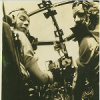The very purpose of a sealer is to seal unlike types of layers from one another. I'm willing to bet that any factory directions for their paint product line will tell you to apply sealer when painting enamel over cellulose/lacquer, and vice versa. Epoxy happens to be an excellent sealer.
Now let me describe the terms I'm using, so that I'm not using a term that means something else to another person. Highly simplified and not indicative of varying chemistries:
Cellulose/lacquer paints - paints that dry and harden solely through solvent evaporation. The base solvent dries and leaves the solid color layer behind. There is no chemical hardening or linking. That's why, if you re-wet it with its base solvent, you can eventually soften it and wipe layers of it off.
Enamel paints - paints that, after evaporation of their reducer carrier, undergo chemical reaction to fully harden. The paint molecules chemically link to each other, and become impossible to dissolve with the original reducer. (not to say some other powerful solvent can't break it down, but the original reducers cannot.) That's why the products used to thin enamels are typically called reducers, not solvents.
However, using natural means for chemical drying means the paint takes a long, long time to dry (harden.) Unaccelerated enamel can take months to dry, which is why in the old days they told us not to polish our enamel finishes for six months after painting.
To speed this up, you can use 1) heat, which is what the factory uses with their huge baking ovens or 2) an accelerator additive that catalyzes the hardening process and speeds it up greatly. 2K paints of this nature, and the most durable finishes use dangerous isocyanate accelerators in varying intensities.
If a 2K paint can be softened or rubbed down by a 2K thinner, then the paint job was botched. After 2K paint fully links chemically, it cannot be dissolved again by its own reducers or thinners. Similar to how, after you pour a water and concrete mix into a block and let it dry, you cannot dissolve the block back into concrete powder by immersing it.
The only thing that should come off is a chalky-flat layer on the surface from aging and abuse (lack of care and protection.) If common solvents could do more than stain a healthy 2K paint layer, then we would all have to repaint our gas filler panels every couple years.
Though again I don't have documentation at hand, I'm certain that few if any factories, much less BMC or British Leyland, use/used 2K paint. That's because they all have large baking booths to speed the hardening action on the paints of their cars. Accelerated paints are mainly used by aftermarket refinishers that cannot bake a car at 200°C for 30 minutes, and makers of large vehicles like transport trucks and airplanes that are too large to practically build baking booths for.
by the way the heating lamps you see in aftermarket paint shops in no way compare to factory baking booths. They help evaporate reducers quickly to minimize the chance of paint runs or sag, and can use infra-red effects to speed the hardening process, but are not comparable. (like a tanning lamp vs. a cooking oven.)
Dave
Edited by bluedragon, 24 March 2019 - 07:24 AM.













